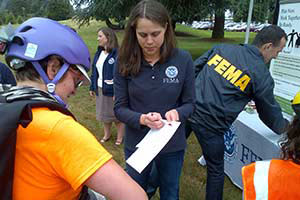
By CTU Faculty
In Colorado Technical University's Homeland Security blog series, Dr. Nadav Morag outlines various careers throughout the field. From the private sector, to the government at federal, state and local levels, homeland security is a wide-ranging field. In this post, Dr. Morag explores the Federal Emergency Management Agency, better known as FEMA.
The Federal Emergency Management Agency (FEMA) is the federal government's primary emergency preparedness, response and recovery coordination agency, and it is a part of the Department of Homeland Security (DHS). FEMA was created by a presidential executive order signed by then President Jimmy Carter. The order brought together existing agencies dealing with insurance, fire prevention, disaster preparedness and civil defense. For many years, FEMA was a separate federal agency, but in March 2003, as part of the massive reorganization of the federal government in the wake of the terrorist attacks of September 11, 2001, FEMA was made a part of the newly established DHS.
FEMA operates within the framework of a number of federal laws, including The Stafford Act, which, among other things, lays out the scope of federal disaster preparedness and mitigation assistance provided to local and state governments. Since the United States has a federal system of government, the majority of public safety and emergency preparedness and response functions reside with city, county, tribal and state governments rather than with the federal government. (This is in keeping with the 10th Amendment to the Constitution, which provides residual powers – those powers not expressly granted to the federal government – to the states.) Since Congress has not empowered the federal government to run most public safety and emergency management functions, these are, by default, in the hands of states and local governments with the federal government providing support when requested. This, in a nutshell, describes FEMA's role. The agency does not take the lead on preparing the country for natural disasters and other emergencies (such as terrorist attacks, hazardous substance spills or war), nor is it the first to respond to disasters and assist in recovery. These roles are, first and foremost, filled by the local and state governments in the impacted areas.
When a disaster occurs, the initial response is up to the local government with help from nearby municipalities, state agencies, volunteer organizations and private-sector entities (such as large retailers, which can provide water and other supplies). Federal resources can also be mobilized where the local government and/or state lack them. For example, FEMA can be called on, via the state governor, to provide search-and-rescue assets, electrical power, food, water, shelter, etc. In general, the system is one that ratchets up the response in proportion to the degree of damage, disruption and economic loss. Broadly speaking, when a disaster occurs, the local government responds first. Then, when it is overwhelmed, the state government response will kick in. Finally, FEMA and other components of the federal government are brought in when the needs of the disaster overwhelm state resources.
When the disaster is a significant one that overwhelms state resources (e.g., hurricanes, earthquakes, floods, tornadoes, major fires, major terrorist attacks, etc.), the state governor requests that the president issue a Major Disaster Declaration, which puts in motion the provision of federal funds for long-term recovery programs that can help private individuals who have lost property as well as help rebuild infrastructures.
FEMA can provide support in the form of financial aid to people impacted by disasters (including low-interest loans to cover the repair of homes and businesses), temporary housing, medical assistance, debris removal, and the rebuilding of roads, utility lines and other infrastructure. FEMA operates via 10 regional offices that work with their respective states and local governments to coordinate FEMA's response.
To get a sense of the federal government's role in dealing with disasters, both in terms of what FEMA does as well as what other federal agencies do, one can look at the 15 Emergency Support Functions (ESFs). Federal disaster relief is divided into the following ESFs: transportation (ESF 1); communications (ESF 2); public works and engineering (ESF 3); firefighting (ESF 4); emergency management (ESF 5); mass care, housing and human services (ESF 6); logistics and resource support (ESF 7); public health and medical services (ESF 8); urban search and rescue (ESF 9); hazardous materials (ESF 10); agriculture and natural resources (ESF 11); energy (ESF 12); public safety and security (ESF 13); long-term community recovery (ESF 14); and public outreach (ESF 15).
In addition to opportunities in emergency management in state and municipal governments, FEMA offers options for people interested in the broader facets of emergency management, response and recovery, touching on all the ESF functions noted above. FEMA employs permanent full-time employees (PFTs); on-call response/recovery employees who are hired for a specific period of two to four years (which may be renewed); reservists, who are hired to respond to specific disasters; and temporary local employees (hired for 120-day terms). The agency also offers internships and has a 10-month program that trains 18- to 24-year-olds for emergency-management careers (this is known as the FEMA Corps).
Emergency-management opportunities, whether in the context of FEMA, other agencies or the private sector, are very diverse and highly rewarding as they help save lives and help people, businesses and governments rebuild when disasters strike.
For a good overview of emergency management, please see the FEMA independent study course, "Fundamentals of Emergency Management."

